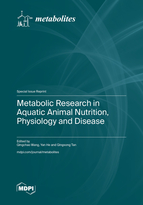Metabolic Research in Aquatic Animal Nutrition, Physiology and Disease
A special issue of Metabolites (ISSN 2218-1989). This special issue belongs to the section "Animal Metabolism".
Deadline for manuscript submissions: closed (31 July 2023) | Viewed by 28535
Special Issue Editors
Interests: fish nutritional immunology; immunometabolism; amino acid metabolism
Interests: fish sex determination; sex differentiation; sex control; sexual dimorphism; gonadal development and reproduction; genomics; transcriptomics; gene expression; genetics and selective breeding; selection of new varieties
Special Issues, Collections and Topics in MDPI journals
Special Issue Information
Dear Colleagues,
Aquaculture supplies large quantities of high-value proteins to human beings and remains the most efficient protein-producing industry. Fish feed is the largest cost during aquaculture practice, and it is of great importance to explore the nutrient requirements and physiology of different aquatic animals. The last decade has seen a growing number of studies revealing the metabolic responses in aquatic animal nutrition, physiology and disease.
The inner metabolic regulatory mechanism in aquatic animal nutrition, physiology and disease remains largely unresolved. This Special Issue showcases a collection of original research and review articles that highlight the latest discoveries and advances in the field of metabolic research in aquatic animal nutrition, physiology and disease. In improving our understanding of the metabolic regulation in multiple aspects of aquatic animals, there is potential to develop functional feed components or high-efficiency fish feed, to finally promote the continual blooming of the aquaculture industry.
Dr. Qingchao Wang
Dr. Yan He
Dr. Qingsong Tan
Guest Editors
Manuscript Submission Information
Manuscripts should be submitted online at www.mdpi.com by registering and logging in to this website. Once you are registered, click here to go to the submission form. Manuscripts can be submitted until the deadline. All submissions that pass pre-check are peer-reviewed. Accepted papers will be published continuously in the journal (as soon as accepted) and will be listed together on the special issue website. Research articles, review articles as well as short communications are invited. For planned papers, a title and short abstract (about 100 words) can be sent to the Editorial Office for announcement on this website.
Submitted manuscripts should not have been published previously, nor be under consideration for publication elsewhere (except conference proceedings papers). All manuscripts are thoroughly refereed through a single-blind peer-review process. A guide for authors and other relevant information for submission of manuscripts is available on the Instructions for Authors page. Metabolites is an international peer-reviewed open access monthly journal published by MDPI.
Please visit the Instructions for Authors page before submitting a manuscript. The Article Processing Charge (APC) for publication in this open access journal is 2700 CHF (Swiss Francs). Submitted papers should be well formatted and use good English. Authors may use MDPI's English editing service prior to publication or during author revisions.
Keywords
- metabolic regulation
- aquatic animal nutrition
- fish physiology
- aquatic animal disease









